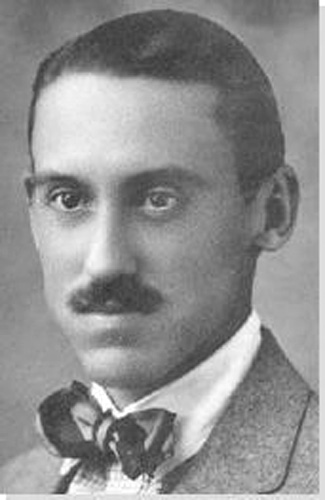 |
Charles Demuth | |
| Birth Date: November 8, 1883 |
||
| Death Date: October 23, 1935 Artist Gallery |
||
| The son of a wealthy Lancaster, Pennsylvania, tobacco merchant, Demuth never had to seek the approval of others or work for a living. However, lameness from a hip disease contracted in childhood caused him to be emotionally dependent on his mother Augusta, and this, combined with his conflicted feelings about his homosexuality, made Demuth believe he was an outsider.
Due to Demuth’s hip disease, he was bed ridden for a year as a child, during which time he was given watercolor paint and drawing books to keep him occupied. He also took art lessons, and two years after graduating high school in 1903, he enrolled in introductory art courses at Philadelphia's Drexel Institute of Art, Science, and Industry. Later, with the encouragement of his teachers, Demuth completed his studies from 1905 to 1910 at the Pennsylvania Academy of Fine Arts.
Though Demuth was burdened with hip disease, he traveled, danced, swam, hiked, golfed, and maintained a charming wit that people greatly enjoyed. Trips to Europe during and after his five years at the academy in 1907 and from 1912 to 1914 exposed Demuth to the Fauve and German Expressionist art that was to influence his own style. While in Europe, he also enrolled in drawing courses at the Académie Moderne and was even in Gertrude Stein’s salon with Picasso and later with Hemingway, and became close with Marcel Duchamp. He returned to live in Lancaster after the death of his father in 1912, and began a lifelong relationship with Robert Locher, an Art Deco interior decorator and stage designer who was also from Lancaster.
When Demuth returned to America, he divided his time among New York, Lancaster, and New England seaside resorts, where he spent his summers. It was during his New England summers, particularly in Provincetown under the influence of artist Marsden Hartley, that he developed the precisionist style for which he is known. He also frequented the artistic circle around Alfred Stieglitz (1864-1946) in New York City, where it’s possible that he met artist Georgia O’Keeffe. Unlikely friends, Charles Demuth and Georgia O'Keeffe forged a connection that fed each artist on a personal as well as an artistic level. O’Keeffe noted, “he was a better friend to me than any of the other artists.”
In 1920, Demuth was diagnosed with diabetes and was often incapacitated by diabetic attacks, yet he continued to work in Lancaster and travel to New York. Whenever Demuth was in New York, O'Keeffe and Stieglitz would see him. Their many outings were occasionally punctuated with medical emergencies, as Demuth would have to be rushed to medical help due to a diabetic attack. Rather than distancing their relationship, these instances actually formed a closer bond between the artists. Early in the twenties, prior to marrying Stieglitz, O'Keeffe began to visit alone with Demuth in Lancaster. During her visits she would stay at the Weber hotel, across the street from the Demuth family home and tobacco shop, and take her meals with Charles and his mother. It was during O'Keeffe's visits to Lancaster that the two artists painted in the garden at Demuth’s house, using the same subject matter and developing their own styles.
Demuth made a final trip to Europe in 1921, fell seriously ill with diabetes, and was brought home by his mother for insulin treatment. He never regained full health, and spent most of the rest of his life working at home in Lancaster. Indeed, most of his finished works were created in his Lancaster home, where he worked in a small second floor studio overlooking the garden. The garden was tended by his mother Augusta and was the inspiration for many of his paintings.
Demuth exhibited in numerous solo shows and in group shows with artists such as John Marin, Georgia O'Keeffe, Arthur Dove, Marsden Hartley, and Alfred Stieglitz. Over a period of two decades he produced more than a thousand drawings and paintings. Demuth died of complications from diabetes in 1935, at age 51. In his will he bequeathed his watercolors and estate to Robert Locher, and all his other works to Georgia O’Keeffe. She played a crucial role in distributing them to the major art museums of the country, such as the Museum of Modern Art in New York, the Art Institute of Chicago, the Santa Barbara Museum, and many others.
|
||


